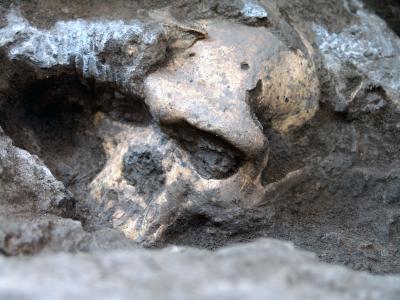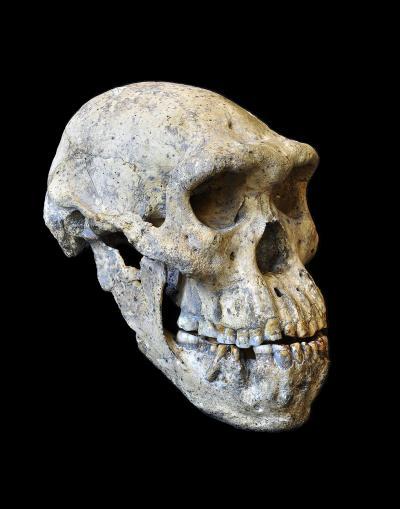The fifth skull to be discovered in Dmanisi displays a combination of features unknown to researchers before the find - the largest face, the most massively built jaw and teeth and the smallest brain within the Dmanisi group.
Previously, four equally well-preserved hominid skulls as well as some skeletal parts had been found there. Taken as a whole, the finds show that the first representatives of the genus Homo began to expand from Africa through Eurasia as far back as 1,850,000 years ago.
Because the skull is completely intact, it can provide answers to various questions which up until now had offered broad scope for speculation - namely, the evolutionary beginning of the genus Homo in Africa around two million years ago at the beginning of the Ice Age, also referred to as the Pleistocene.
The debate is whether there were several specialized Homo species in Africa at the time, at least one of which was able to spread outside of Africa too, or a single species that was able to cope with a variety of ecosystems.

Dmanisi early Homo cranium in situ. Credit: Georgian National Museum
The early Homo finds in Africa demonstrated large variation but it has not been possible to settle on answers to these questions. Christoph Zollikofer, anthropologist at the University of Zurich, explains why the fossil evidence wasn't enough. "Most of these fossils represent single fragmentary finds from multiple points in space and geological time of at least 500,000 years. This ultimately makes it difficult to recognize variation among species in the African fossils as opposed to variation within species."
What the new fossil means, they say, is that the earliest members of our Homo genus— Homo habilis, Homo rudolfensis, Homo erectus and so forth — actually belonged to the same species and simply looked different from one another.

Dmanisi skull 5. Credit: Guram Bumbiashvili, Georgian National Museum
As many species as there are researchers
Marcia Ponce de León, also an anthropologist at the University of Zurich, points out another reason: paleoanthropologists often tacitly assumed that the fossil they had just found was representative for the species, i.e. that it aptly demonstrated the characteristics of the species.
Statistically this is not very likely, she says, but nevertheless there were researchers who proposed up to five contemporary species of early Homo in Africa, including Homo habilis, Homo rudolfensis, Homo ergaster and Homo erectus. Ponce de León sums up the problem as follows: "At present there are as many subdivisions between species as there are researchers examining this problem."
Dmanisi offers the key to the solution, the authors say. According to Zollikofer, the reason why Skull 5 is so important is that it unites features that have been used previously as an argument for defining different African species. In other words, "Had the braincase and the face of the Dmanisi sample been found as separate fossils, they very probably would have been attributed to two different species."
Ponce de León adds, "It is also decisive that we have five well-preserved individuals in Dmanisi whom we know to have lived in the same place and at the same time."
These unique circumstances of the find make it possible to compare variation in Dmanisi with variation in modern human and chimpanzee populations. Zollikofer summarizes the result of the statistical analyses: "Firstly, the Dmanisi individuals all belong to a population of a single early Homo species. Secondly, the five Dmanisi individuals are conspicuously different from each other, but not more different than any five modern human individuals, or five chimpanzee individuals from a given population."

A computer reconstruction of the five Dmanisi skulls (background: Dmanisi landscape). Credit: Marcia Ponce de León and Christoph Zollikofer, University of Zurich, Switzerland
Diversity within a species is thus the rule rather than the exception. The present findings are supported by an additional study (see the second citation below). In that study, Ponce de León, Zollikofer and further colleagues show that differences in jaw morphology between the Dmanisi individuals are mostly due to differences in dental wear.
This shows the need for a change in perspective: the African fossils from around 1.8 million years ago likely represent representatives from one and the same species, best described as Homo erectus. This would suggest that Homo erectus evolved about 2 million years ago in Africa, and soon expanded through Eurasia – via places such as Dmanisi – as far as China and Java, where it is first documented from about 1.2 million years ago.
Comparing diversity patterns in Africa, Eurasia and East Asia provides clues on the population biology of this first global human species.
This makes Homo erectus the first global player in human evolution. Its redefinition would provide an opportunity to track this fossil human species over a time span of 1 million years.
References:
David Lordkipanidze, Marcia S. Ponce de León, Ann Margvelashvili, Yoel Rak, G. Philip Rightmire, Abesalom Vekua, and Christoph P.E. Zollikofer, 'A complete skull from Dmanisi, Georgia, and the evolutionary biology of early Homo', Science, October 18, 2013. doi: 10.1126/science.1238484
Ann Margvelashvili, Christoph P. E. Zollikofer, David Lordkipanidze, Timo Peltomäki, Marcia S. Ponce de León, 'Tooth wear and dentoalveolar remodeling are key factors of morphological variation in the Dmanisi mandibles', Proceedings of the National Academy of Sciences, September 2, 2013. doi: 10.1073/pnas.1316052110






Comments